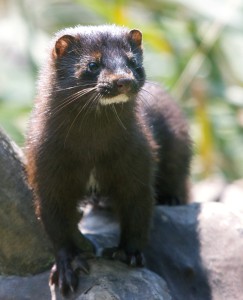 These animals are excellent swimmers and divers, and they possess a number of amphibiotic adaptations. They are the monotonic dark black-brown in coloration. The American mink, in contrast to the European one, has a white spot on the lower lip only. These two species also stand apart by certain peculiarities in the structure of teeth and skull. The American mink is notably larger and stronger than the European. The animal can often be over 45 cm long, with 15-25 cm of tail, and weighing up to 1.5 kg.
These animals are excellent swimmers and divers, and they possess a number of amphibiotic adaptations. They are the monotonic dark black-brown in coloration. The American mink, in contrast to the European one, has a white spot on the lower lip only. These two species also stand apart by certain peculiarities in the structure of teeth and skull. The American mink is notably larger and stronger than the European. The animal can often be over 45 cm long, with 15-25 cm of tail, and weighing up to 1.5 kg.
The American mink inhabits almost the entire territory of North America, with the exceptions of the northeast and far south of the continent. Besides, it is acclimatized and widespread in many areas of Europe and Northern Asia. In Russia, this mint was first introduced in 1933. In those environs where the American mink was introduced into the habitats of the European mink, the former – as a stronger species – drove out and exterminated the local, since they claim the same sites. This is what happened in the Pskov Region.
The lifestyles of the two species are similar, but in the course of the year American minks regularly change their habitats traveling quite far away from water bodies when migrating.
Minks are mating in the spring, with the snow cover still present, and the American mink mates approximately a month before the European. The breeding biology in American minks is well-studied, as it is bred in farms. The gestation can be between 34 and 78 days, depending on the length of latency, which can change between 14 and 30 days. Kits occur in late spring or early summer. There are up to 9 of them per litter, sometimes to 11, and there were litters of 18 registered in the US. They grow to adult size by the fall.
/ * The photos at lake.peipsi.org are cross-posted from commons.wikimedia.org and are used for familiarization purposes only. No commercial use of the photos is allowed. For more information about to use the photos see the originals on commons.wikimedia.org. /


